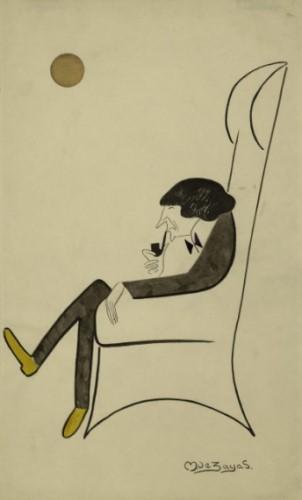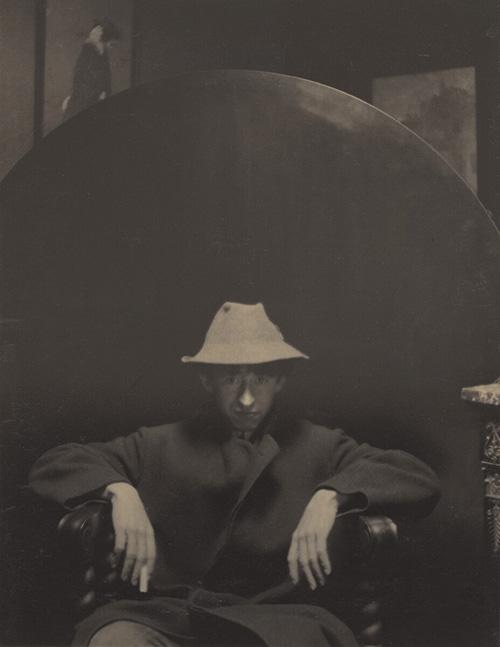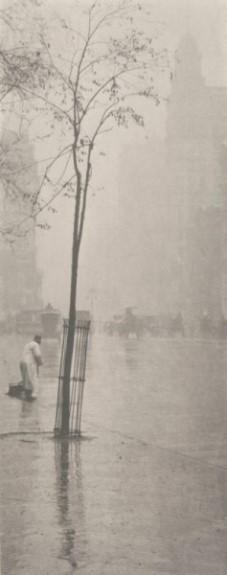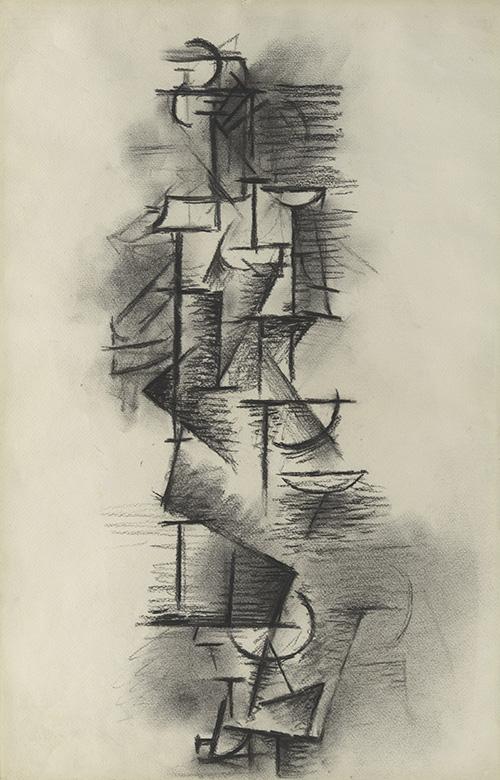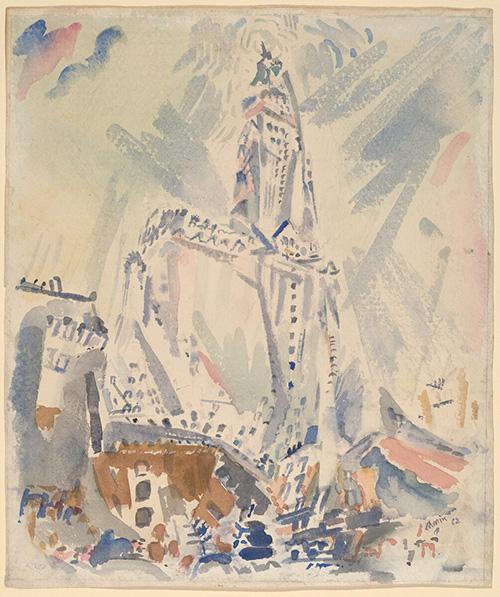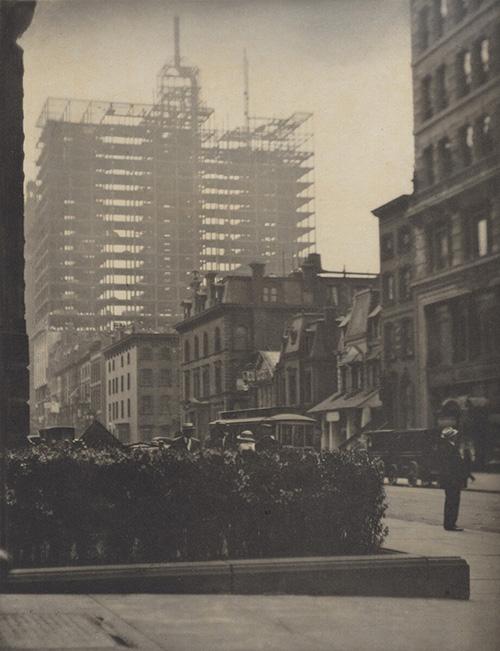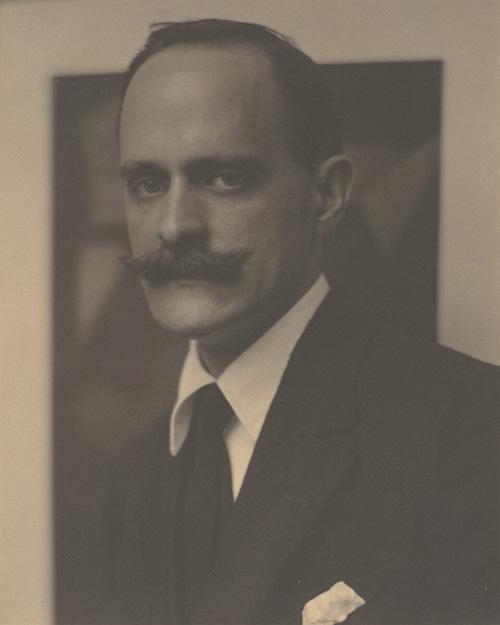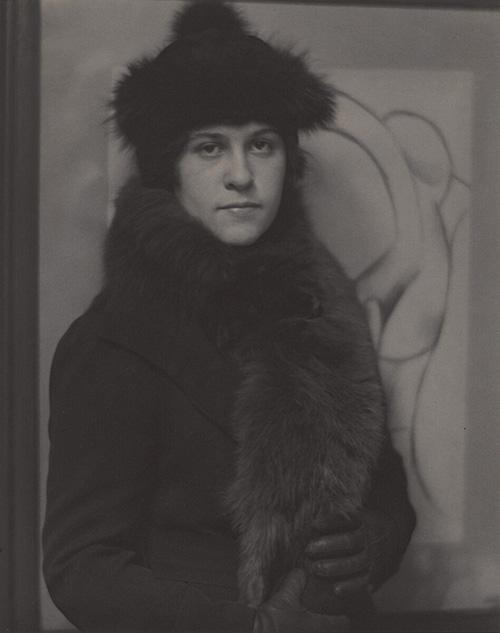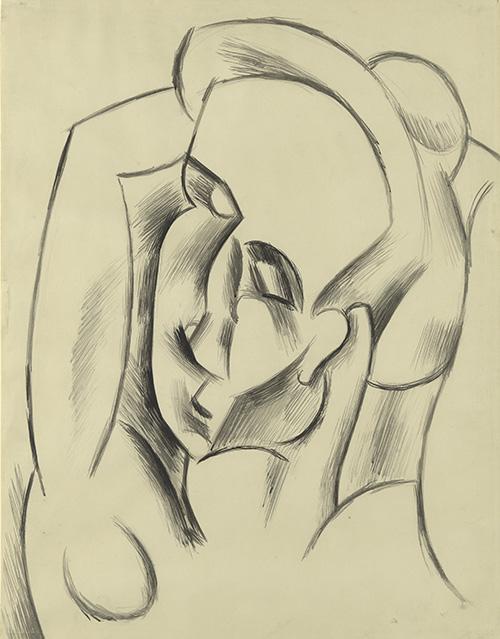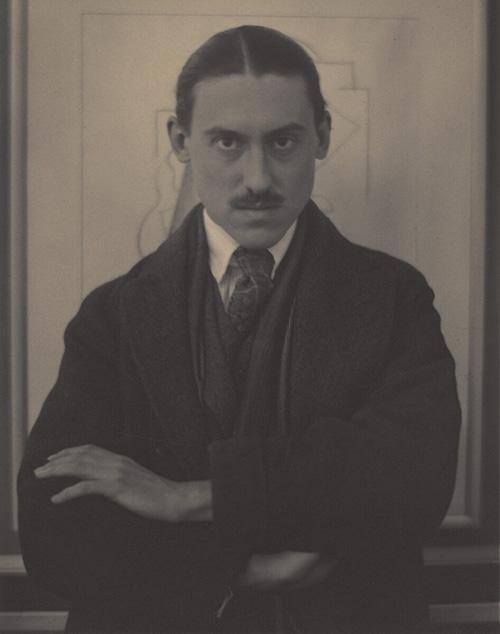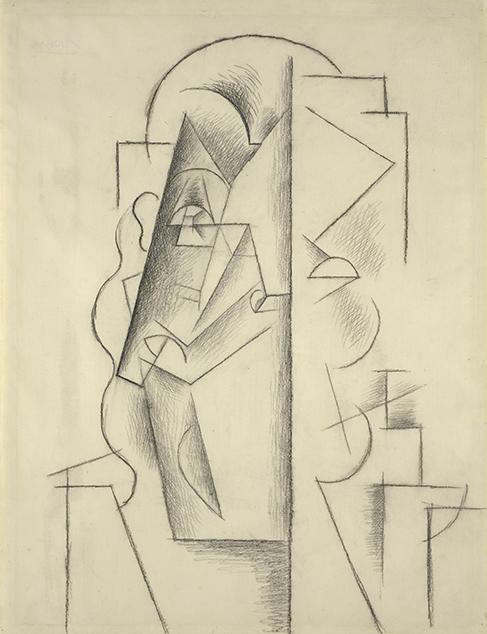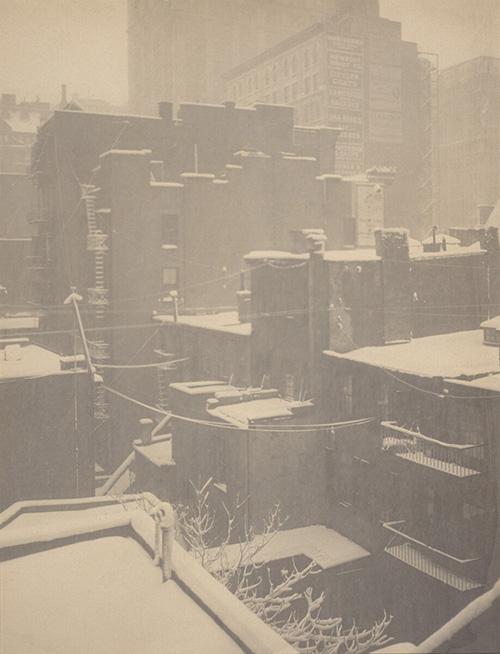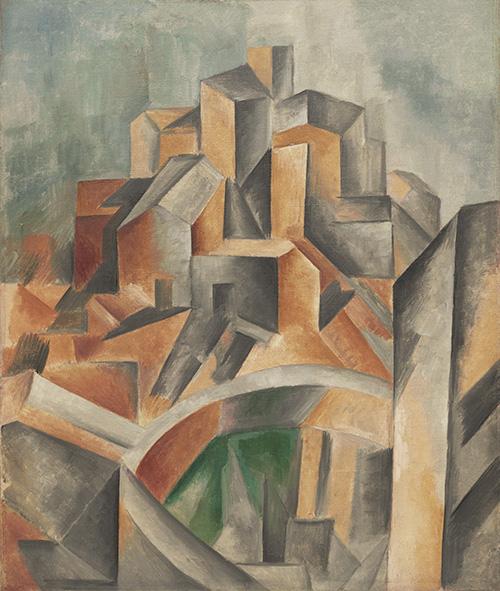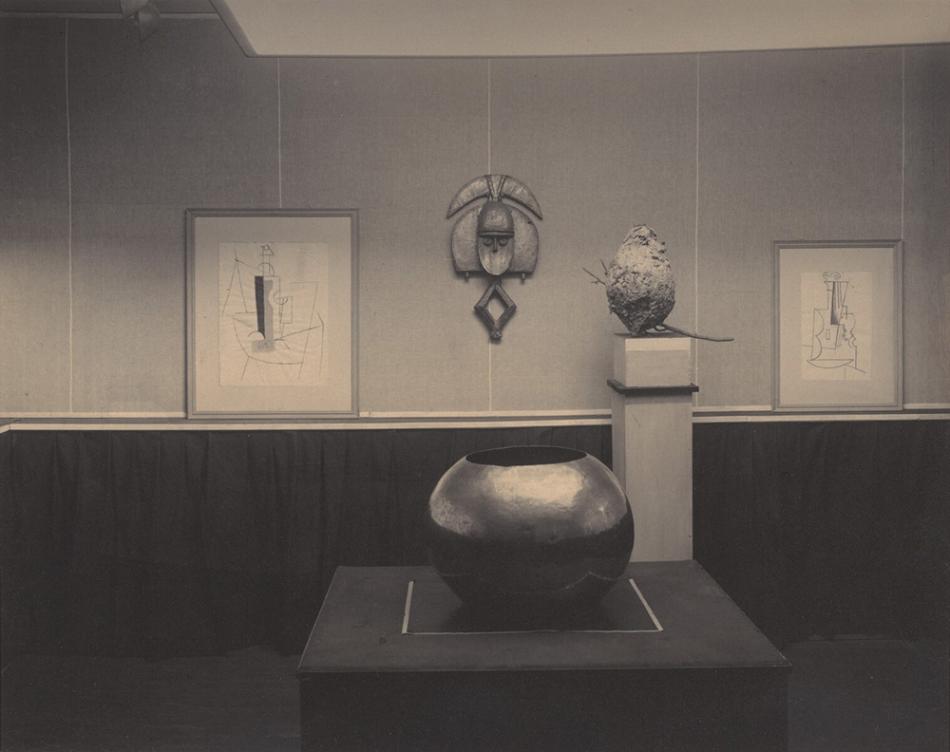The Key Set: 1902–1917
Publication History
Published online

Alfred Stieglitz, The Steerage, 1907, printed in or before 1913, photogravure on cream moderately thick smooth wove Japanese paper, National Gallery of Art, Washington, Alfred Stieglitz Collection, 1949.3.292
Key Set number 312
Alfred Stieglitz, The Steerage, 1907, printed in or before 1913, photogravure on cream moderately thick smooth wove Japanese paper, National Gallery of Art, Washington, Alfred Stieglitz Collection, 1949.3.292
Key Set number 312
Stieglitz made few photographs in the early years of the twentieth century and instead concentrated on using the work of others to demonstrate the artistic merit of photography. In 1902 he founded the Photo-Secession, a group of handpicked photographers whose work, he believed, represented the finest examples of the art of photography; that same year, he also began publishing Camera Work (1902–1917), a lavishly produced periodical that sought to introduce the latest developments in photography and the other arts. In 1905 he, along with his colleague, the photographer and painter Edward Steichen, opened The Little Galleries of the Photo-Secession (1905–1917) at 291 Fifth Avenue in New York, where he initially exhibited work by members of the Photo-Secession and other leading photographers of the time.
Yet in 1907, a few days after his forty-third birthday, he opened a show of seventy-two drawings by an obscure English artist, Pamela Colman Smith. With it, he embarked on a phase in his career that would profoundly affect not only twentieth-century American culture, but also his own photographs. In the next ten years, he presented an ever-increasing number of exhibitions of drawings, watercolors, paintings, and sculpture by many of the leading European modernist artists, including Paul Cézanne, Henri Matisse, Pablo Picasso, and Constantin Brancusi. They introduced him to new ideas of color, form, and abstraction and new sources of artistic inspiration in so-called primitive or naïve art, popular culture, and the machine that deeply influenced his art. Although he continued to draw inspiration from painting, he looked not so much at their subjects and styles but at the implications of their ideas for photography. Between 1907 and 1917 he made few photographs—a little more than 150 are included in the Key Set—but these are far more accomplished than any of his work from the 1890s. He did not preserve all of the photographs he made during these years, but, unlike before, he did not eliminate whole categories or subjects and made an effort to keep only what he considered to be his best work. Those that he retained provide a concise history of the evolution of his understanding of modern art and its implications for modern photography.
After 1907, with ever-increasing intensity, Stieglitz immersed himself in modern art. Between 1908 and 1910 he presented exhibitions at 291 of Auguste Rodin (1908, 1909, and 1910), Henri Matisse (1908 and 1910), Marius de Zayas (1909 and 1910), Alfred Maurer (1909 and 1910), John Marin (1909 and twice in 1910), Marsden Hartley (1909 and 1910), Henri de Toulouse-Lautrec (1909), Henri Rousseau (1910), Arthur B. Carles (1910), Arthur Dove (1910), and Max Weber (1910). He read widely and on trips to Europe in 1907 and 1909 saw exhibitions, visited dealers, met many collectors and artists. Although notoriously talkative and opinionated, he looked, listened, and learned. He was “spellbound,” he later said, listening to Leo Stein’s discourse in 1909 on the necessity of viewing both modern and more conservative art in a wider, even global context and on Cézanne’s ability to render “mass with a vital intensity” and reveal the “plastic beauty” of form. In New York the younger American artists who came to 291 in ever-increasing numbers also educated him. Max Weber was particularly instructive. In Europe from 1905 through 1908, he had met many of the leading artists, including Matisse and Picasso; visited the Trocadero Museum to see the African sculpture; and immersed himself in the work of Rousseau and Cézanne. Stieglitz later acknowledged that through his discussions with Weber he was able “to enlighten myself in a way in which I couldn’t have otherwise in America.”

Figure 1
Alvin Langdon Coburn, Williamsburg Bridge, 1910, photogravure, from the portfolio New York, National Gallery of Art, Washington, Alfred H. Moses and Fern M. Schad Fund, 2009.134.1
These influences began to come together in Stieglitz’s 1910 photographs of New York City. Although interest in New York as a pictorial and literary subject continued to grow throughout the 1900s, most artistic photographers, especially those associated with Stieglitz’s elite group, the Photo-Secession, were slow to adopt it. Even Stieglitz stopped recording the city after 1903. Steichen photographed the Flatiron Building in 1904, after Stieglitz and in a decidedly Whistlerian manner, but few others were drawn to urban imagery until the spring of 1910 when Alvin Langdon Coburn, a young American, published a portfolio of twenty studies of New York’s towering skyscrapers, cavernous streets, and bustling harbor with a formal boldness unknown in pictorial photography (fig. 1). Stieglitz applauded Coburn’s efforts, but he was clearly challenged by him to re-assert his prior pictorial claim to the subject. And he did. In the summer of 1910 he made a series of photographs of New York with a visual complexity, graphic intensity, and celebratory energy new to his images of the city. Most were taken as he commuted from Deal Beach, New Jersey, where his family was vacationing, and thus he, like Coburn and countless other artists and immigrants, approached the city from the waterfront. Shedding his lack of specificity, muted tone, and hesitant vision from the turn of the century, Stieglitz focused on the icons of New York’s modernity. He photographed New York’s newest and tallest buildings, including the Singer Building, and he depicted the crenellated skyline of the city with puffs of smoke billowing from its towering skyscrapers, as if it were an engine running on full throttle (Key Set numbers 339–342). He emphasized the bustle of its harbor, the size and strength of the tugboats and ferries that moved people and things through this new environment, and he recorded the fastest and largest ocean liner, the Mauretania, which plied its busy port (Key Set numbers 331–343). The new New York that Stieglitz presented was a potent mixture of architectonic magnitude and brute strength, of movement and change, and of promise.
More visually and conceptually complex than any of his earlier work had been, Stieglitz’s photographs drew on the dense patterning and compression of pictorial space used not only by Coburn, but also by the American modernist artists Arthur Dove, Marsden Hartley, Arthur B. Carles, Alfred Maurer, John Marin, and Weber, all of whom he had exhibited in the spring of 1910. Often measuring more than 13 × 10 inches, his photographs mimicked the size of many of their watercolors and drawings. But, more important, Stieglitz learned from them a new and more overtly displayed formal consciousness. In Outward Bound, The Mauretania, for example, the massive, white pilings of a ferry slip in the foreground are directly echoed by the dark smokestacks of the more distant ocean liner, while in The City across the River the forms of the pilings are repeated in the tugboat’s smokestack in the middle ground and the skyscrapers on the horizon (Key Set numbers 334–338). Stieglitz did not go so far as to reorganize “the natural into a purely plastic domain,” as Weber argued that Cézanne had done, but he did express the energy and mass of the city with a modernist formal self-consciousness that caused “the static to vibrate.”
These New York photographs, though, were not only exercises in form. Made along the waterfront and depicting the city from a distance, they impart a sense of passage, transition, and psychological separation. As in The City across the River or The City of Ambition, Stieglitz anchored his viewer on the opposite shore, removed from the new city (Key Set numbers 337 and 341). Even in Old and New New York, where a person in the middle ground surveys the scene, Stieglitz separated himself, and thus the viewer, from the spectacle by a sidewalk, curb, and hedge (Key Set numbers 344 and 345). We, like Stieglitz, witness from afar the construction of a new skyscraper in the background but are not part of the life of the street. Even the photogravure prints that Stieglitz made of these works between 1910 and 1913, while far less atmospheric than his views from the turn of the century, are nevertheless dark and heavy, further contributing to a sense of pause and reflection.
Having reasserted his command of the material, Stieglitz returned to the subject that preoccupied him during the years of 291: portraiture. Recognizing that much of the most innovative art of the period—from Rodin to Matisse and Picasso—was focused on the human form, he sought to clarify its implications for photography by examining this subject in his work. In the spring of 1910, at approximately the same time that the Mexican artist Marius de Zayas made a caricature of Marin, Stieglitz and Steichen together made a photograph of Marin in a similar setting (figs. 2 and 3). Although roughly the same size, the photograph and the drawing are in many ways exact opposites of each other: the dark photograph with rich details of face, expression, dress, and surroundings presents the painter head-on, while the highly simplified drawing, consisting of only a few lines and minimal blocks of watercolor wash and gold paint, shows him in profile. Yet both works, by emphasizing his slouching pose, prominent nose, and long delicate hands, capture Marin’s waggish, laconic nature, and together they indicate the kind of dialogue between painting and photography that Stieglitz sought to construct at 291.
De Zayas’ work fascinated Stieglitz because the simplification and license of caricature so clearly embodied the idea, as Caffin wrote in 1908, that modern art, in order to distinguish itself from photography, must deal “not with facts of sight, but with ideas of the imagination.” Or, as Stieglitz asserted, because “the camera had the advantage over the best trained eye and hand, the logical deduction was that the other arts could only prove themselves superior to photography by making their aim dependent on qualities other than accurate reproduction.” They had to be “non-photographic.” It was, of course, a simplistic comparison, for non-representational art was not only the result of the invention of photography. But, within the confines of 291, which sought to formulate an aesthetic for photography by comparing it to the other arts, it was an idea that was easily grasped and frequently espoused.
This non-photographic, or what Stieglitz would later call anti-photographic art, based on ideas, not sight, found its most radical expression in a 1911 exhibition of Picasso’s artistic evolution from 1906 through 1910. While some landscapes, such as those made in Horta in 1909, may have been shown, most works displayed were figurative studies. Reviewers were hostile, but Stieglitz recognized that the show was “possibly the most interesting one yet held” at 291 and instead of regarding Picasso’s work as the “gibberings of a lunatic,” as the critics did, he found it “as perfect as a Bach fugue.” When he stood before Picasso’s drawing Standing Female Nude, which he bought from the show, he “gained from it a genuine stimulus”; for him it was “an intellectual cocktail.”
Immediately after the Picasso exhibition closed, Stieglitz went to Paris. There he had “long most interesting sessions with or at Picasso, Matisse, Rodin, Gordon Craig, Vollard, Bernheims, Pellerin’s; finally winding up with two days at the Louvre which in reality I saw for the first time.” We do not know what Picasso and Stieglitz talked about, but it is tempting to think they spoke of photography. At the time Picasso took photographs, including ones he used as studies for his paintings and watercolors made in Horta, but he also analyzed photography as a system of visual representation. He mined the ways in which the camera compresses space and stacks planes one on top of another and he understood how different lenses flatten forms, making structural elements seem to splay out at their edges, becoming almost one with their surrounding environment. Moreover, Picasso realized that by making photographs of his paintings in progress he could rethink, in a more neutral tonal range, the formal and compositional relationships within his works. If Stieglitz met Picasso in his studio, he may have seen how the artist used photographs to explore alternative paths in his work by drawing on, cutting, or pasting photographs together, sometimes even merging what had previously been two or more separate pieces into a new photographic collage.
Stieglitz was deeply impressed by their meeting. That fall, he wrote, that although “Matisse is doing some beautiful work. . . . Picasso appears to me the bigger man. I think his viewpoint is bigger.” He “is the great force in the plastic arts,” Stieglitz concluded, who “will bring art back to its true expression.” In the fall 1911 issue of Camera Work, which included sixteen reproductions of his photographs—far more than any previous issue—Stieglitz linked his most modernist work to date with Picasso’s art. He sequenced the photographs carefully. For example, the towering Singer Building first seen in The City of Ambition is echoed in the next photograph, The City across the River, and the dense Old and New New York, with its gridlike structures, is followed by The Aeroplane, with its dark but empty sky and skeletal bi-plane (Key Set numbers 341, 337, 344, and 349). Seeing strengths in previously neglected photographs, Stieglitz returned to earlier works, including The Terminal, 1893, which he reproduced for the first time, contrasting its dark forms and intimate horse-drawn trolley with the emphatically modern steam locomotive, In the New York Central Yards, 1903 (Key Set numbers 93 and 286). Most explicitly, he concluded the issue with reproductions of his Spring Showers, New York followed by Picasso’s Standing Female Nude (figs. 4 and 5). The formal similarities between the two are clear: both are skeletal forms, composed of thrusting vertical elements broken by diagonal lines and circular shapes, and each has a radiating central form that almost merges with the surrounding space.
In the spring of 1913, at the time of the large international exhibition of modern art, the Armory Show, Stieglitz seized the opportunity to mount a series of concise, carefully orchestrated presentations at 291 that helped him clarify his ideas about the relationship between modern art and photography. The first was a show of John Marin’s latest work, the second was an exhibition of his own photographs, and the third was of work by the French modernist Francis Picabia. All three included numerous depictions of New York, enabling Stieglitz to demonstrate succinctly how two painters and one photographer and two Americans and one European artist responded to the new city (figs. 6 and 7). For Stieglitz these three shows were conclusive proof that photography, while using an entirely different vocabulary, could more than equal the other arts. Having proven this, he returned to his exploration of portraiture.
Immediately thereafter Stieglitz presented an exhibition of caricatures by de Zayas and published two articles by him in Camera Work that articulated a new theory for modern photography. Again comparing painting to photography, de Zayas argued that while modern art was based on ideas and presented emotional or intellectual truths, photography was “a negation of all representative systems.” Thus the new or “pure” photography was capable of surpassing art because it could provide “the plastic verification of fact” so urgently demanded by the modern scientific age. De Zayas drew on a Platonic idea of form—that works of art can allow us to see the universal in the particular—but he also expressed the shared cultural belief that just as X-rays revealed realities invisible to the human eye, so too could other types of photography present “material truths” about objects to enable “a new way to progress in the comprehension of form.” In this way, de Zayas believed, the new photographer would do synthetically what the new painters were doing analytically.
After proudly proclaiming that with these articles “the meaning of photography as a medium of expression is finally getting its place,” Stieglitz made several portraits. Using 291 as his studio and an integral part of his statement, he shed the theatricality and soft-focus of his earlier portraits and positioned his sitters before works of art (see, for example, Key Set numbers 366 and 369). During de Zayas’ exhibition, Stieglitz posed him in front of his caricature of John Marin and Alfred Stieglitz (figs. 8 and 9). Literally placing de Zayas within the frame of his own work, Stieglitz further layered photography over drawing by echoing the shape of Marin’s collar seen in de Zayas’ caricature in his own depiction of de Zayas’ collar, and by repeating the shape of his bow tie in the drawing in his rendition of the Mexican artist’s mustache. A witty repartee between the two media and between observer and observed, artist and subject, Stieglitz’s photograph also compared what de Zayas had called “the material truth” of photography with the abstraction possible in painting or drawing. Adding Marin to this visual dialogue, Stieglitz also photographed him in front of this same work by de Zayas (Key Set number 385).
In late 1914 and early 1915 Stieglitz pushed these ideas still further. First, in November and December 1914 he mounted what he described as “possibly the most important show we have ever had,” an exhibition of African art. Like others of his time, Stieglitz was fascinated with African art. He believed this non-mimetic work—like the children’s art he also exhibited at 291—was less analytical and also a purer, more immediate and unfiltered expression of the unconscious mind. As such, he saw it as one more reason, as de Zayas wrote, why painters should “abandon the complex study of realistic form . . . and turn to the imaginative and fantastic expression of Form.”
After the African art exhibition closed, Stieglitz showed two more exhibitions of Picasso’s work. In addition to several drawings of heads from 1909, the show included a number of Picasso’s and Braque’s innovative papiers collés and collages from 1912 that incorporated actual objects or pieces of paper—newspaper, sandpaper, fabric, or caning—into the compositions. Recognizing their potency, Stieglitz bought Picasso’s papier collé Still Life: Bottle and Glass from the show. Including a piece of paper that could be read, it demonstrated how an object in these constructions could simultaneously function as both content and form—how something that was real could also signify more than itself. The optical, tactile, and textual ambiguities of the papiers collés that Picasso designed “to fool the mind,” not the eye, fascinated Stieglitz. Proclaiming it “the most important Picasso drawing” he had ever seen, Stieglitz asserted that it was also the “most complete ‘abstraction’ of the modern movement.”
Stieglitz incorporated some of Picasso’s works from this exhibition into several portraits made at this time. Revealing his understanding of the cubists’ desire to extend objects out into the surrounding space in order to organize the pictorial plane along new coordinates, he sought to merge his subjects with Picasso’s art. By using the monochrome palette of photography he equalized the disparities of color between photography and the other arts and he also matched the scale of his subjects to the works in the background. He posed Kitty in front of Picasso’s Head of a Woman so that her hat—itself a designer’s play on the bun in a woman’s hair—was echoed in the bunlike form in the drawing, and he did much the same with his secretary, Marie Rapp, positioning her in front of the same work so that the curve of her collar merged with the lines of the drawing (figs. 10 and 11, and Key Set number 400).
Going head-to-head with the cubist master, he also photographed the American painter Charles Demuth in front of Picasso’s Head of a Man, 1912, aligning Demuth’s ear to repeat the ear of Picasso’s man, the part in his hair to coincide with the dominant vertical line in the Picasso drawing, and his white collar to duplicate other forms in the work (figs. 12 and 13). In these photographs Stieglitz did not merely adapt cubist strategies, but demonstrated how he could turn life into art and force representation and abstraction, fact and idea, modern photography and modern painting, to confront and engage one another on an equal visual and conceptual plane.
As if testing how his new understanding of art and photography would affect his continuing relationship with the city, in the spring of 1915 Stieglitz photographed out of the back windows of 291 (Key Set numbers 417–423, and fig. 14). Although other photographers had earlier studied similar subjects, Stieglitz once again used painting, not photography, and more specifically Picasso as a starting point for formulating a new approach. With their compressed space, absence of foreground, stacked and tilted planes, gridlike forms, and study of humble views, not grand vistas, his photographs from 1915 are remarkably similar both to Picasso’s Mill at Horta, which may have been shown at 291 in 1911, and to The Reservoir, Horta de Ebro, which was reproduced in Camera Work in 1912 (fig. 15). Far less iconic and dramatic than his 1910 views of the city, Stieglitz’s 1915 photographs record the patterning of lights in office buildings at night or snow on adjacent roof tops and indicate that he, like Picasso, was fascinated with revealing the underlying architectonic structure of the city. Although Picasso twisted the geometric structures of the houses far more than Stieglitz was able to do and used contradictory shadows, both artists minimized detail and purposefully obfuscated passages so that it is difficult to determine what is roof or wall, substance or void.
At some point, most likely during the course of the Picasso exhibitions, Stieglitz, perhaps aided by others, took a reliquary figure from the African art exhibition and arranged and photographed it with a papier collé and a drawing by Picasso, a wasps’ nest and a brass bowl, one of the recurrent symbols of 291. Although he titled the resulting work 291—Picasso-Braque Exhibition, recent research indicates that it is not a document of the actual exhibition, but a temporary installation, an elaborate, short-lived still life—just like those constructed by Picasso and Braque—designed to provoke discussion (fig. 16). As he did in his portraits made at this time, he linked all the objects so that the curvilinear lines in the drawings and the outline of the Kota reliquary, the wasps’ nest, the brass bowl, and even 291’s lighting fixtures all echo one another. His intention was clear: he wanted to challenge his viewers to consider art and nature, European and African notions of beauty, and what he considered to be an intellectually based art, a naïve art, and a natural one. Undercutting the traditional hierarchies that placed greater value on European art than on African or natural art, Stieglitz hung the reliquary slightly above the two Picasso drawings, which only rest on the shelf, while he positioned the wasps’ nest at their same level.
This work represents a significant step in Stieglitz’s development. Unlike his earlier, self-consciously artistic photographs in which he copied the subject matter and style of painters—as he had done with Passini or Hasemann, for example—he now used the actual art of others as his raw material, much as Picasso and Braque had used real objects in their collages as their raw material. Just as Picasso cut up the newspaper, subverting its original intention, so too did Stieglitz co-opt these objects and transform them into his own work of art, infusing them with a new meaning. And, just as Picasso and Braque used found objects rather than traditional materials and cutting, gluing, and constructing in place of drawing or painting in order to break down the barriers between art and life, so too did Stieglitz in this temporary construction extend their ideas of papier collé and collage out into the gallery space itself. Playing, like the European modernists, at the intersection of fact and illusion, object and construction, art and life, Stieglitz demonstrated, as de Zayas had predicted in 1913, that photography could do synthetically what other modern artists were doing analytically.
Stieglitz’s art achieved a new level of maturity in early 1915. Now fully understanding the graphic complexity and analytic, gridlike structure of The Steerage, 1907, he returned to it and reproduced it in the avant-garde periodical 291 (Key Set number 313). Although in later years he claimed to have immediately recognized its importance, he did not reproduce The Steerage until 1911 or exhibit it until 1913 and seems not to have conceived of it as a picture “of shapes related to each other,” expressive of his feelings “about life,” as he would later claim, until he reached this fuller understanding of Picasso’s art.In 1914 Zayas showed The Steerage to Picasso and, as the Mexican artist excitedly recounted in a letter to Stieglitz, Picasso, after confessing “that he has absolutely enter[ed] into the field of photography,” admired The Steerage, and “came to the conclusion that you are the only one who has understood photography.” Noting the relationship between the new French art and Stieglitz’s work, de Zayas wrote in 291 that The Steerage not only validated the work of Picasso, Braque, and others, but also pointed the way toward the future of twentieth-century photography. A reviewer sarcastically but perceptively remarked, “one can imagine a Cézanne abstractionist putting tracing paper on The Steerage and abstracting the woman seated in a deeply reflective attitude as representing the sum of the human interest of the scene, or a Picassonian abstracting the gangway and the steerage ladder, with their fine composition of straights and curves, as providing the essential signature of the scene.” Thereafter, whenever Stieglitz described The Steerage, with its “round straw hat, the funnel leaning left, the stairway leaning right,” he sounded as if he were speaking about a Picasso drawing or a Kandinsky painting and not a photograph of a group of beleaguered people.
At the same time Stieglitz also returned to Sun Rays—Paula, Berlin, 1889. Early in his career he had made a few studies that included his own photographs or other works of art, but, not understanding their implications, he did not exhibit or reproduce them in the 1880s or 1890s. By 1916, though, when he made the platinum print of Sun Rays—Paula, Berlin now in the Key Set, he certainly saw it, too, in an entirely new way (Key Set number 60). With its strong geometric structure, its patterning of light and shade, and the carefully constructed dialogue between the photographs of Paula hanging on the wall and the woman herself in the foreground, and the photographer and his subject, Sun Rays—Paula, Berlin is remarkably similar in meaning and structure to his portraits of Kitty and Marie Rapp from 1915, as well as his 1913 study of Marius de Zayas.
Invigorated by his heady engagement with Picasso’s work, Stieglitz made more than seventy photographs, mainly portraits from January 1915 through the close of 291 in July 1917 that are now in the Key Set. It was his most productive period while directing the gallery. To be sure, he undoubtedly wanted to preserve some record of the individuals whose work and ideas enlivened the gallery. (At the same time he devoted an entire issue of Camera Work to the question “What is 291?” with contributions by more than sixty people.) He also had more time: as other galleries opened in the wake of the Armory Show, 291 was no longer the only gathering place for avant-garde artists. But to a large extent, his increased productivity was due to his greater confidence in his photography and its relationship to the new art, his objectives and his direction.

Figure 17
Alfred Stieglitz, Francis Picabia, 1915, platinum print, National Gallery of Art, Washington, Alfred Stieglitz Collection, 1949.3.363
Key Set number 403
In 1915 and 1916, while other 291 artists made increasingly more abstract portraits, Stieglitz’s became more detailed and sharply focused, more about texture, pattern, and particulars of skin and clothing. Where artists such as de Zayas and Picabia used mechanically inspired forms to comment, often slyly, on their subjects’ intellectual, even sexual abilities, or painters such as Marsden Hartley used color, form, and other symbols to evoke an intense but forbidden love, Stieglitz looked for a union of subject, setting, and formal elements as well as gesture and expression that collectively expressed his understanding of the subject’s personality. He continued to unite artists with their art, often with their own self-portraits. In 1915 he posed Picabia in front of his paintings This Has to Do with Me and Comic Wedlock, repeating the shape of the artist’s tie, the arch of his shoulders, even the creases in his jacket in the biomorphic and sexually charged paintings in the background (fig. 17 and Key Set number 403). His studies of “the men” of 291, as he referred to them, became progressively more complex as he energized every facet of the picture plane. His portraits of Picabia, for example, are as dense and richly patterned—as much pictures of shapes and their relationship to one another—as is The Steerage. In his 1916 portraits, such as those of George F. Of, a painter and frame maker, or William Zorach, a sculptor, he used the edges of his compositions in a new way, allowing objects—in both cases, paintings by Hartley—to intrude into his composition, framing his subjects and locating them within the dynamic space of 291, but also suggesting the fragmentary nature of his art (Key Set numbers 431 and 432).

Figure 18
Paul Strand, Wall Street, New York, 1915, mercury-toned platinum print, Aperture Foundation, Inc., Paul Strand Archive. © Aperture Foundation, Inc., Paul Strand Archive
During the fall of 1915 and winter of 1916 the young American photographer Paul Strand began to frequent 291 with ever-increasing regularity and showed Stieglitz his bold, innovative photographs of New York (fig. 18). While Strand’s vision of the city was a place where individuals were often dwarfed by their surroundings and imperiled by its chaotic rush, he also conveyed the dynamism of this new environment where people, streets, and buildings alike pulsed with energy. Surely inspired by these photographs, Stieglitz continued his own more quiet, methodical studies out of the back windows of 291 (Key Set numbers 424–428). Often made at dusk or dawn when few people were about, they depict empty windows, or the looming structure of a nearby building under construction. In the early 1890s Stieglitz had roamed about New York, using his photographs as a way of exploring the city and his relationship to this new environment: as he scrutinized it, he clarified his position within the city, his reaction to it, as well as his objectives for his photography. He continued to regard New York the same way in these later works, but his view was more fixed and reflective as he repeatedly examined the same vistas over several months. Using the window as a poetic device to link the internal and external, he explicitly contrasted what was happening inside 291 with what he saw outside, writing to Georgia O’Keeffe in 1916, “the window at 291 was quite marvelous to-night as I looked out.—It seemed so restful out there—the buildings all lit up looming in the mist—& below my own window—rooftops of neighboring houses.—Inside the room the atmosphere was thick—there was a sullen face.”
In 1916 and 1917 Stieglitz made several photographs that both summarize the liberating impact of modern art on his photography and suggest the direction of his work in the next several years. The first were a series of snapshots made at his family’s summer house in Lake George, New York. Using his 4 × 5-inch camera—a tool that he had not extensively used for several years—he playfully photographed Ellen Koeniger as she swam in the lake, as well as his and Abraham Walkowitz’s reflections in the shallow water (Key Set numbers 442–452, and 439–441). These joyous depictions—including one of himself as a half-human, half-machine creature—reveal his new-found confidence in his ability to encapsulate the spirit of a moment with the most minimal means and to create art out of anything, not just grand subjects, important people, or evocative vistas. As early as 1907 he had recognized the power and complexity of the casually seen and instantly captured snapshot and, as in Snapshot—In the New York Central Yards, even incorporated the word into his titles (Key Set number 284). But not until these 1916 photographs, with their unstudied celebration of the moment and their complete acceptance of a constant state of flux was Stieglitz able to exploit a snapshot aesthetic so effectively. While they are reminiscent of his lantern slides from the 1890s and some of his studies of Kitty from the turn of the century, they also suggest the carefree snapshots he would make at Lake George in the 1920s and his studies of clouds.

Figure 19
Alfred Stieglitz, Fountain, 1917, gelatin silver print, private collection
In 1917 Stieglitz displayed his eagerness to stay at the edge of avant-garde experimentation by installing, exhibiting, and photographing Marcel Duchamp’s Fountain after it was rejected from the exhibition of the Society of Independent Artists (fig. 19). Stieglitz recognized the reasoning behind the Fountain—that a utilitarian object, placed in a new setting, and given a new meaning, became an aesthetic object—could be applied equally effectively to the art of photography. To emphasize this point, he created another temporary installation. Appropriating the Fountain, just as Duchamp had appropriated the original plumbing fixture, he turned it into his own work of art. He took a Hartley painting, The Warriors, from storage, placed it on the floor and positioned the Fountain on a pedestal, so that the lines of the urinal were echoed in the forms of Hartley’s painting. Whereas earlier in the 291—Picasso-Braque Exhibition he had brought nature and African art into the urbane space of 291, elevating both to positions of prominence, now he gave a machine-made object the place of honor on the pedestal, carefully lighting it to reveal both its sculptural beauty and enigmatic qualities. And, playing on its scatological allusions, he positioned Fountain so that it was directly beneath the tail of one of the horses in Hartley’s painting. Curiously, just as Duchamp did not bother to save the original Fountain, Stieglitz did not save a print of this photograph, suggesting that neither fully appreciated the significance that history would bestow on this event.
On 1 June 1917, just a few weeks before 291 closed, Stieglitz made four portraits of Georgia O’Keeffe that are preserved in the Key Set (Key Set numbers 457–460). In the past few years, he had made a few photographs of the “women” of 291, as he had of the “men,” but with rare exceptions—Kitty at 291 and Marie J. Rapp—he treated them differently. With his romantic and symbolist heritage firmly in place, and as a dedicated reader of Havelock Ellis, Edward Carpenter, Herbert Spencer, and Sigmund Freud, Stieglitz understood women—or as he expressed it in his letters “Woman”—as fundamentally different from men. For him, they were more intuitive, subjective, and sensual, and less analytical, cerebral, and objective than men—and therefore needed to be presented in different ways. When he photographed the women of 291, he located them within the space of the gallery, but rarely against works of art. Even the painter Katharine Rhoades, whose work Stieglitz exhibited in 1915, was not depicted in front of one of her or anyone else’s paintings (Key Set numbers 407–410). Instead, with his fin-de-siècle understanding of her as a giver of life, he surrounded her by light and had her gently place her hand on the molding of the doorway, as if transferring her energy not only to the place but also to Stieglitz himself. In June 1917, Stieglitz photographed two men in a similar fashion: Hodge Kirnon, the West Indian elevator operator, and Emil Zoler, a handyman who helped hang exhibitions—men whom he saw as “pure,” untutored, and naïve. (Key Set numbers 463, 464, 461, and 462).
But, because O’Keeffe was the single most important artist Stieglitz had discovered, he was initially as ambivalent about how to photograph her as she was of being photographed by him. Since he had first seen her art in January 1916, he had come to believe that she was a largely untutored genius whose work was, as a critic later wrote, “entirely and locally American.” From these American roots, Stieglitz asserted, she developed highly personal abstractions of “amazing psychological frankness.” Because she was, in his opinion, an exceptional artist, she deserved to be depicted in the same way he had presented other important artists; that is, in front of her art with aspects of her clothing and head echoed in the forms in her own watercolors (Key Set numbers 457 and 458). But he was also deeply intrigued by what he saw as her ability to fuse her intellect and emotions—“brain and heart,” as he described it—and express not just her ideas and feelings, but also her sexuality. On the first day he photographed her, he also had her place her hands so that they gently caressed the curving forms of her watercolor Blue 1, suggesting an equation between her artistic creation and procreation itself (Key Set number 459). And, as he revealed in his fourth study of her elegant hands and fingers, poised in front of the bodice of her dress, he was also profoundly attracted to her as a woman. In their serial nature, fragmentation, fascination with O’Keeffe as an artist and a woman, and their explicit sexual tension, these four studies from 1917 contain the germs of ideas that would consume Stieglitz for the next several years.
Originally published 2002; minor adaptations have been made for the presentation of this text online.



